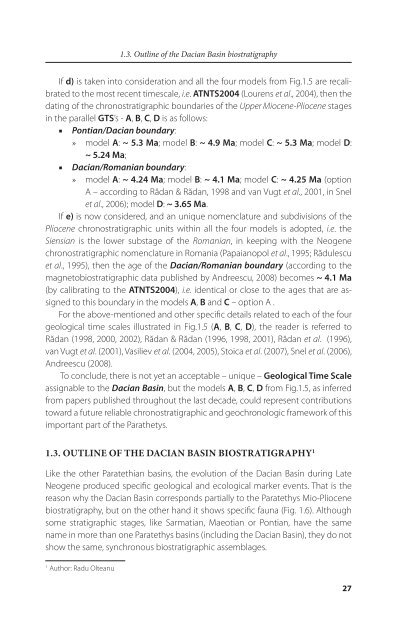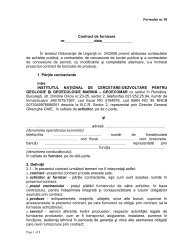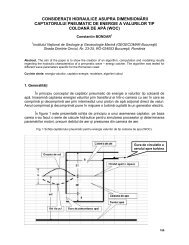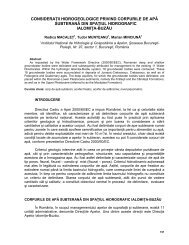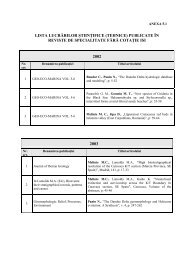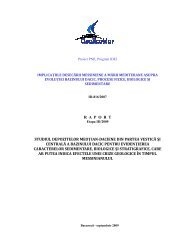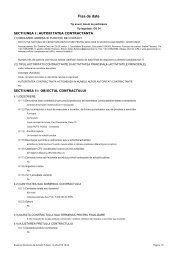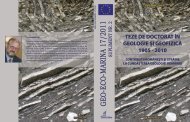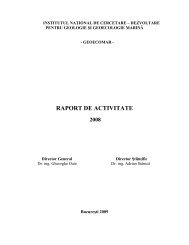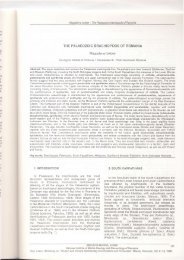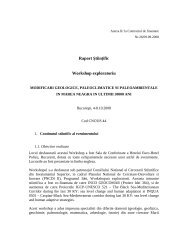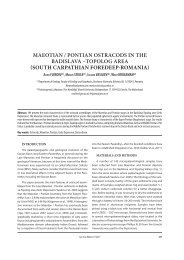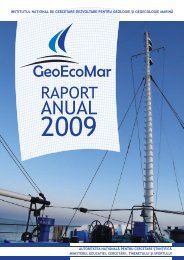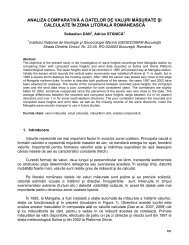DACIAN BASIN - GeoEcoMar
DACIAN BASIN - GeoEcoMar
DACIAN BASIN - GeoEcoMar
Create successful ePaper yourself
Turn your PDF publications into a flip-book with our unique Google optimized e-Paper software.
1.3. Outline of the Dacian Basin biostratigraphy<br />
If d) is taken into consideration and all the four models from Fig.1.5 are recalibrated<br />
to the most recent timescale, i.e. ATNTS2004 (Lourens et al., 2004), then the<br />
dating of the chronostratigraphic boundaries of the Upper Miocene-Pliocene stages<br />
in the parallel GTS’s - A, B, C, D is as follows:<br />
■ Pontian/Dacian boundary:<br />
» model A: ~ 5.3 Ma; model B: ~ 4.9 Ma; model C: ~ 5.3 Ma; model D:<br />
~ 5.24 Ma;<br />
■ Dacian/Romanian boundary:<br />
» model A: ~ 4.24 Ma; model B: ~ 4.1 Ma; model C: ~ 4.25 Ma (option<br />
A – according to Rădan & Rădan, 1998 and van Vugt et al., 2001, in Snel<br />
et al., 2006); model D: ~ 3.65 Ma.<br />
If e) is now considered, and an unique nomenclature and subdivisions of the<br />
Pliocene chronostratigraphic units within all the four models is adopted, i.e. the<br />
Siensian is the lower substage of the Romanian, in keeping with the Neogene<br />
chronostratigraphic nomenclature in Romania (Papaianopol et al., 1995; Rădulescu<br />
et al., 1995), then the age of the Dacian/Romanian boundary (according to the<br />
magnetobiostratigraphic data published by Andreescu, 2008) becomes ~ 4.1 Ma<br />
(by calibrating to the ATNTS2004), i.e. identical or close to the ages that are assigned<br />
to this boundary in the models A, B and C – option A .<br />
For the above-mentioned and other specific details related to each of the four<br />
geological time scales illustrated in Fig.1.5 (A, B, C, D), the reader is referred to<br />
Rădan (1998, 2000, 2002), Rădan & Rădan (1996, 1998, 2001), Rădan et al. (1996),<br />
van Vugt et al. (2001), Vasiliev et al. (2004, 2005), Stoica et al. (2007), Snel et al. (2006),<br />
Andreescu (2008).<br />
To conclude, there is not yet an acceptable – unique – Geological Time Scale<br />
assignable to the Dacian Basin, but the models A, B, C, D from Fig.1.5, as inferred<br />
from papers published throughout the last decade, could represent contributions<br />
toward a future reliable chronostratigraphic and geochronologic framework of this<br />
important part of the Parathetys.<br />
1.3. OUTLINE OF THE <strong>DACIAN</strong> <strong>BASIN</strong> BIOSTRATIgRAPHY 1<br />
Like the other Paratethian basins, the evolution of the Dacian Basin during Late<br />
Neogene produced specific geological and ecological marker events. That is the<br />
reason why the Dacian Basin corresponds partially to the Paratethys Mio-Pliocene<br />
biostratigraphy, but on the other hand it shows specific fauna (Fig. 1.6). Although<br />
some stratigraphic stages, like Sarmatian, Maeotian or Pontian, have the same<br />
name in more than one Paratethys basins (including the Dacian Basin), they do not<br />
show the same, synchronous biostratigraphic assemblages.<br />
1 Author: Radu Olteanu<br />
27


